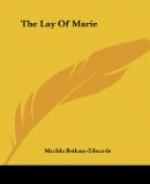Flos comitum, Wilhelmus obit,
stirps regia, longus
Ensis vaginam capit habere
brevem.[17]
This earl died in 1226;[18] so that Mary must have written her fables before that time. The brilliant reputation she had acquired by her lays, had no doubt determined William to solicit a similar translation of Aesopian Fables, which then existed in the English language. She, who in her lays had painted the manners of her age with so much nature and fidelity, would find no difficulty in succeeding in this kind of apologue. Both require that penetrating glance which can distinguish the different passions of mankind; can seize upon the varied forms which they assume; and marking the objects of their attention, discover, at the same moment, the means they employ to attain them. For this reason, her fables are written with all that acuteness of mind, that penetrates into the very inmost recesses of the human heart; and, at the same time, with that beautiful simplicity so peculiar to the ancient romance language, and which causes me to doubt whether La Fontaine has not rather imitated our author, than the fabulists either of Rome, or of Athens. It most, at all events, be admitted that he could not find, in the two latter, the advantages which the former offered him. Mary wrote in French, and at a time when that language, yet in its infancy, could boast of nothing but simple expressions, artless and agreeable turns, and, on all occasions, a natural and unpremeditated phraseology.
On the contrary, Aesop and Phaedrus, writing in Latin, could not supply the French fabulist with any thing more than subject matter and ideas; whilst Mary, at the same time that she furnished him with both, might besides have hinted expression, manner, and even rhyme. Let me add, that through the works of La Fontaine will be found scattered an infinite number of words in our ancient language, which are at this day unintelligible without a commentary.
There are, in the British Museum, three MS. copies of Mary’s fables. The first is in the Cotton library, Vesp. b. xiv. the second in the Harleian, No. 4333; and the third in the same collection, No. 978. In the first, part of Mary’s prologue is wanting, and the transcriber has entirely suppressed the conclusion of her work. This MS. contains only sixty-one fables. The second has all the prologue, and the conclusion. It has 83 fables. The third is the completest of all, and contains 104 fables. M. le Grand says that he has seen four




